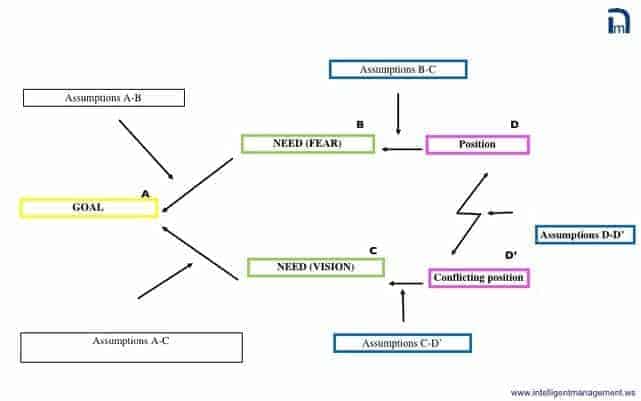Why is so much thinking in organizations vague? It’s not because people lack intelligence or qualifications. Fact is that the kind of thinking that can produce high quality results at a systemic level needs to be learned. But who is teaching it?
The faster our world and our markets change through technology, the faster we must acquire systemic thinking skills to think through the shifts and innovations required to lead, adapt or simply keep up. Before we take a look at a method for improving our systemic thinking skills, let’s look at one of the major obstacles to improving our thinking.
The dangers of too much linear thinking
Linear thinking has served humanity well. Being rational allowed us to emerge from the dark ages and the realm of superstition. We can thank René Descartes for providing us with a whole system of knowledge and investigation, including the ability to locate a point in space by giving its relative distance from perpendicular intersecting lines. By reference to the two coordinate axes, any point, line, or figure may be precisely located.
This logic brings us directly to the notion of a matrix. Once again, matrices have allowed us to deepen our understanding of many phenomena. The excel spreadsheet exemplifies the idea of a matrix. The feeling of power and control that tackling problems using a Cartesian approach gives us is incomparable. The problem comes when we try to apply “rational” methods beyond their scope.
The Excel spreadsheet is a case in point. It certainly has its merits and is a useful tool for many tasks. However, it becomes an issue when we elevate Excel (or Numbers or any other spreadsheet) to the ranks of a management tool and use it for efforts that require something quite different.
Limited view of reality
By relying heavily on matrices, we create a dangerously limited view of our reality as organizations. Given the complexity of managing and controlling the combined efforts of many people, it can be tempting to resort to something that gives us the impression of control, such as an organization structured as a matrix.
This is linear thinking and it is too limited to encompass the full complexity of human organizations as we understand them today. It leads you to think, erroneously, that if you optimize all the parts the whole will do better.
Linear thinking focuses on addressing “symptoms” instead of looking for what is causing the symptoms to happen. It fails to recognize that it takes time for a signal to propagate through a system and so the result of an action can only be seen much later, making it harder to understand where the result came from in the first place. It induces us to concentrate on costs and not on how to maximize throughput and it confuses price with value.
Imposing old patterns
Linear thinking imposes old patterns; it expects more of the same because it sees a past that continues in a linear way into the future and is therefore blindsided to disruption.
We can’t keep managing organizations thinking that everything is linear and that a hierarchical functional organization with silos is adequate for today’s complexity. What we know today that we could not know fifty years ago is that organizations are made up of networks, and they exist within other networks, and all of these networks are made up of multiple interconnections that increase their complexity.
The relations within a network evolve in a nonlinear way. We may even consider the conflicts that inevitably arise as explosions of nonlinearity. We may state that nonlinearity is the key to interpreting all complex phenomena that arise spontaneously when several entities interact, be they biological or human.
Digitization is accelerating the need to reshape organizations to function beyond silos. Leaders and managers urgently need to get a grasp of knowledge of nonlinearity and learn how to manage organizations in a completely new light. In other words, the evolution that takes us from silos towards a network requires not just a shift in how we organize our work but in how we think.
How can we boost our systemic intelligence and learn to think in a non-linear way?
Learning how to change is perhaps the greatest challenge we face and the most urgent one. Technology demands it and to fully embrace and leverage new technologies to our benefit we need to learn to think systemically. However, this is not usually something that we are taught at school. Indeed, thinking skills in general are not taught, beyond the ability to analyze something logically in terms of grammar or high school math.
Thinking, however, is never a purely logical activity. It is always informed by our emotions, fears and desires. Above all, our thinking is ‘clouded’ by our assumptions and the mental models we inevitable bring with us as part of how our brains have developed.
These assumptions are intimately connected with our personal experiences and the environments where we learned to interact with the world. It is perfectly understandable that people from different backgrounds have different worldviews. However, when people need to interact to achieve a goal, these differing worldviews often lead to conflict.
The creative nature of conflict
A conflict is a form of “constraint”. The “conflict cloud” developed by Eliyahu Goldratt as part of the systemic Thinking Processes from the Theory of Constraints is a powerful, structured and highly effective way to leverage conflict as an opportunity for breakthrough and innovation. It frames conflict as an opportunity for creativity.
Why is this Thinking Process so powerful? Because no matter the conflict addressed, it takes into consideration for all parties the two fundamental human drivers: control (this connects with fear) and vision (this connects with desire). In any conflict, these two needs exist in a variety of manifestations and any sustainable solution must respect and protect them. This is key to achieving success through conflict.

Without the creative friction that comes from conflict and the intrinsic limiting elements we experience in every situation we try to improve, we will never discover the elements that lead to a systemic solution and real innovation.
With this article, Domenico Lepore continues his mini-series of articles that focuses on how to build companies that are fit for the digital age. The next one will be about the conflict cloud and the human constraint on the path to change.





















Add Comment